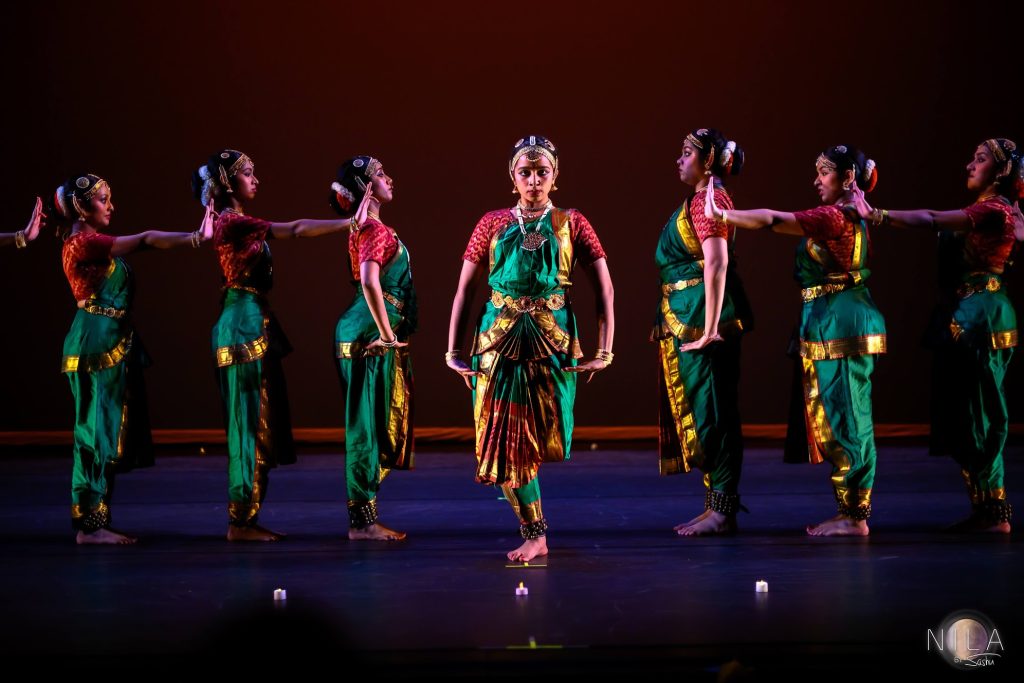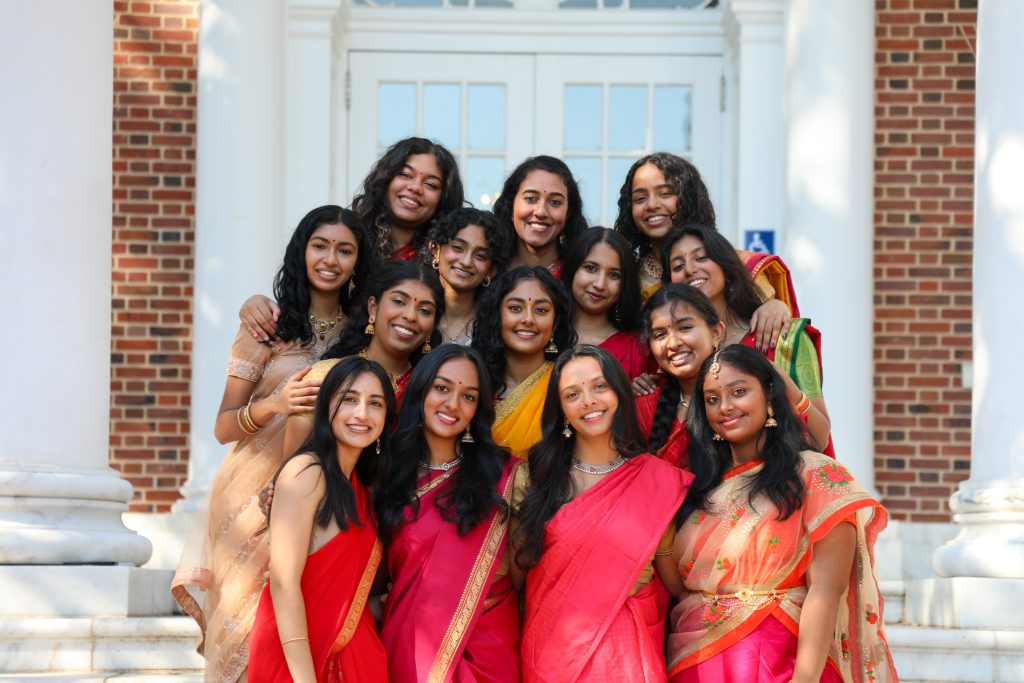
Dance as Tradition, Resistance, and Celebration
Catch JHU Shakti live at Hopkins India Conference 2025 on May 9–10, 2025!
Johns Hopkins University’s premier Indian classical dance team, JHU Shakti, is set to take the stage at the upcoming Hopkins India Conference on May 9–10, 2025. With a legacy of excellence in Bharatanatyam, Shakti has captivated audiences for over two decades through dynamic storytelling, intricate formations, and expressive performances. As they prepare for this special event, the team reflects on their journey, achievements, and the deep cultural significance of their art form.
Can you share how JHU Shakti was founded, its evolution over the years, and what sets it apart in the collegiate dance scene?
Neha: Shakti is the premier competitive Indian Classical Dance team at Johns Hopkins University. Since 2003, the dancers of JHU Shakti have excelled in precision, and hold dear the value of the classical and historical South Indian dance form known as Bharatanatyam. The team dedicates their time to the mastery of expression, hand movements, and footwork, and seeks to convey a powerful cultural-rooted story through classical dance to all audiences. The members of Shakti each bring a rich training background, which the team melds into dynamic performances featuring traditional steps set to fast-tempo beats, complex formations, and moving narratives.

Shakti has grown tremendously in the intercollegiate dance competition space over the years, having placed University of Maryland’s Mayuri Dance Competition in 2013 and at University of Pittsburgh’s Dhirana in 2016. In the 2022 – 2023 season, Shakti competed in 3 intercollegiate competitions and placed 2nd at University of Pittsburgh. Last year marked the first time that Shakti placed at all our regular season competitions and qualified for the Origins National Championship in Chicago for Indian Classical Dance, where we finished 4th place overall. We will be headed back out to Chicago for the Origins National Championship again this year!
Shakti has made an incredible mark on the collegiate competition circuit, recently qualifying for the Origins National Championship. What have been some of your biggest achievements, and how has competing at this level shaped the team?

Ananya: One of Shakti’s biggest achievements in our recent past would be partaking in and excelling in the competitive circuit. The dancers on our team all have an immense passion for Bharatanatyam and have been learning and practicing for over a decade. Being able to convey and perform stories that are important to our background and culture in a competitive scene and share our dance and interpretations with other top teams in the nation is an amazing experience and honor for us. While like any other performing arts group, Shakti was founded based on a passion and love for the art form, being able to compete and place at competitions in recent years has been an unimaginable experience. Rebuilding our team after Covid-19 was difficult, and one of our turning points was Laasya 2024 where we placed 2nd at this bid competition, contributing to our ability to later perform at Origins, the national championships. That moment motivated us to continue to strive to be our best and began our journey of making a mark in the collegiate circuit. Since then we have loved every minute of competing alongside the best teams in the country and furthering our passion for what we do.
What has been your most memorable performance or competition, and why?
Dheeksha: Our most memorable competition this season was probably Laasya in San Francisco in February. We had just competed at UVA the weekend prior and barely got a break before diving back into rigorous practices for Laasya. We were happy with our performance at the UVA competition, but we knew there was a lot of room for improvement. With only a few days to prepare and the stakes higher than ever, we knew we had to give it our all. Everyone on the team was incredibly motivated to make Laasya an even better performance. We stayed focused, supported each other, and put in the work. On show day, we remained calm and collected because we knew we had spent hours refining every nook and cranny of our piece. After performing and watching our video back, we felt incredibly proud of ourselves. Seeing how much improvement we had made in less than a week was shocking. Other dancers in the circuit even came up to us, specifically mentioning the remarkable difference in our sync and cleanliness from the week before. This experience showed us just how much potential we have as a team when we work together. With a positive and collaborative mindset, we proved that we are capable of achieving anything we set our minds to.

How do you incorporate storytelling into your performances? Are there specific themes or messages you aim to convey?
Maya: Storytelling is a fundamental part of Bharatantyam. Through the use of various hand gestures, mudras, and facial expressions, abhinaya, dancers are able to narrate stories. Traditionally, these stories are based on characters and events from Hindu mythology, and are typically in praise of a deity. However, as time has passed, the stories we use Bharatantyam’s rich vocabulary to tell have evolved. Bharatanatyam artists can use the traditional language of the art form to tell stories that a modern audience can relate to. Generally, Shakti’s goal is to tell stories that emotionally move an audience, whether that means reinterpreting traditional myths or telling a completely new story. This year, Shakti created a piece to criticize the practice of caste discrimination, a social issue that affects many in India and Indians abroad as well. It is particularly meaningful that we use Bharatanatyam to condemn this social issue, since the art form itself has historically been inaccessible to lower castes. As a result, our very act of performing this piece is a method of protest, a way to raise awareness in our audiences.
How do you engage with the broader Hopkins community? Do you host workshops, collaborations, or cultural events?
Sandhya: Before our auditions last semester, we hosted workshops for both beginners and advanced dancers. For the beginner workshop in particular, some people got the opportunity to try Bharatanatyam for the first time. On campus, we also perform for holidays like Diwali and Holi and various student group showcases. In the broader Baltimore community, we have partnered with the grassroots organization Expanding Boundaries International, contributing to their goal of making children global citizens. Beyond raising awareness of Indian culture, this partnership has helped our team learn about African food and culture, growing cultural awareness and empathy among all parties.
What advice would you give to students interested in joining the team or getting involved in classical Indian dance?
Neha: Classical Indian dance goes beyond just steps and performance routines; it is a beautiful celebration of our rich culture and history. Through dance, you have the opportunity to connect with your cultural roots and express yourself creatively. It is incredibly rewarding to meet people who share the same passion for dance, learn from each other’s common yet unique backgrounds, and form a close-knit community as a result. The ability to share cultural stories through dance allows you to connect with an audience in a deeply meaningful way. As a competitive collegiate dance team, our preparation can be demanding at times, but the incredible growth we achieve together as a team makes the experience all worthwhile. I’ve made some of my closest friends and built fond memories through being on JHU Shakti, for which I am forever grateful.
What does performing at the Hopkins India Conference mean to you?
Neha: Having the opportunity to perform at the Hopkins India Conference is incredibly exciting for us, as it is always an honor to express our traditions and stories through dance on stage. I’m looking forward to networking with others at the conference and engaging with the community. For me, I grew up in a small town in Pennsylvania, so dance has been a powerful way to gain a deeper understanding of my heritage that I might not have developed otherwise. For many of us on the team, dance has helped grow our cultural identities, allowing us to resonate at a personal level with the overall conference theme of fostering collaboration between the United States and India.
What’s a fun or unexpected fact about JHU Shakti that most people wouldn’t know?
Simren: Many people think that we hire a professional DJ to put together the music for our competition piece, but actually it’s all done and edited by Sandhya, our tech chair! Also, our team’s favorite food during competitions is Taco Bell, we always doordash it to whichever venue we are at.

Join Us at the Hopkins India Conference!
JHU Shakti’s upcoming performance is set to be a highlight of the Hopkins India Conference, offering a breathtaking blend of tradition, innovation, and storytelling. Don’t miss this opportunity to witness their artistry live!
Watch Their Performances:
Meet the Team:
Sandhya Ganesh – Tech Chair
Sandhya is a junior majoring in biomedical engineering from Tampa, Florida. Growing up, she learned both ballet and Bharatanatyam. She completed her Bharatanatyam Arangetram, or dance graduation, the summer after finishing her senior year of high school. In college, she joined the Indian classical dance team JHU Shakti. For the past two years, she has served on the executive board as the Tech Chair, putting together the music and introduction videos for the team’s competition pieces.
Neha Skandan – Treasurer
Neha Skandan is a senior double majoring in Molecular & Cellular Biology and Public Health Studies from Bethlehem, Pennsylvania. She has been learning Bharatanatyam for the past 17 years and completed her Bharatanatyam Arangetram in the summer of 2019. She joined JHU Shakti in college, where she has served on the executive board as Treasurer for the past two and a half years.
Dheeksha Sudhakar – Secretary & Social Chair
Dheeksha Sudhakar is a junior majoring in Molecular & Cellular Biology from South Brunswick, New Jersey. She completed her Bharatanatyam Arangetram in the summer of 2019. She joined JHU Shakti her freshman year, and has served as the team’s secretary and social chair for the past two years.
Simren Shah – Co-Captain
Simren Shah is a junior majoring in Biomedical Engineering from Oklahoma City, Oklahoma. She has been learning Bharatnatyam for 14 years and completed her Bharatnaytam Arangetram in the summer of 2017. She joined JHU Shakti during her freshman year, where has served as Co-Captain for the past two years, choreographing our competition piece and leading practices.
Ananya Ashok – Co-Captain
Ananya Ashok is a junior majoring in Molecular & Cellular Biology and minoring in Psychology. She has been learning Bharatanatyam for the past 17 years and completed her Bharatanatyam Arangetram in the summer of 2019. She joined JHU Shakti in her freshman year, serving as the team’s travel chair for competitions last year and one of Shakti’s co-captains this year.
Maya Britto – Co-Captain
Maya Britto is a sophomore majoring in Public Health from Burtonsville, Maryland. She has been training in Bharatanatyam for 14 years and completed her Arangetram in 2019. She joined JHU Shakti as a freshman, and is currently a co-captain.
For updates and more, follow @JHUShakti on Instagram!